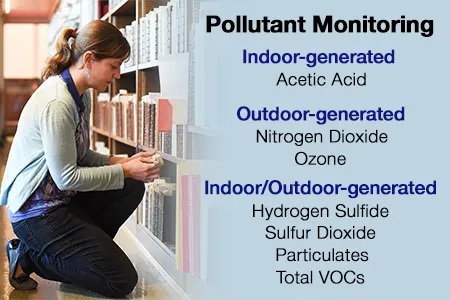Integrating Risk Assessment for Pollutants into Energy-saving Strategies
The National Endowment for the Humanities awarded the Image Permanence Institute a Research and Development grant for $350,000 to support a three-year, field-based research project that will apply data from pollutant and environmental (temperature and relative humidity) monitoring to comprehensively balance these known risks to collections when implementing energy-saving mechanical system operations.
Strategies of temporary system shutdowns, fan speed adjustments, and outside air reduction are proven effective ways to maintain or improve the preservation quality of a collection environment while reducing the financial burden and carbon footprint of a collecting institution, critical challenges in today’s world. However, current criteria guiding safe implementation of energy-saving strategies focus on temperature and relative humidity alone, which ignores the significant risk to collections posed by outdoor and indoor-generated pollutants. This project will address that problem by developing a methodology for monitoring room-level pollutant concentrations while implementing these energy-saving strategies and then analyzing that data to optimize the environment for different kinds of pollutants and energy savings.
Research activities will be organized and led by Kelly Krish, Preventive Conservation Specialist at IPI, who will facilitate a multidisciplinary and multi-institutional project team. IPI project members will collaborate with colleagues in the Golisano Institute for Sustainability (GIS) at RIT, the Canadian Conservation Institute, and an independent consultant in indoor air quality to meet project goals. IPI will also be partnering with three collecting institutions to implement the testing and methodology; applications will be available in Spring 2021 for those interested in collaborating to meet these goals.
The primary outcome will be data collection and a modeling procedure to help institutions balance pollutant-level changes while implementing energy-saving strategies, based on their specific outdoor environment, mechanical system, and collection. The model will be usable by any collecting institution interested in implementing energy-saving strategies to reduce risks associated with pollutants while also managing energy usage.











